Ropes: Little money for good rope - 17 mooring lines put to the test
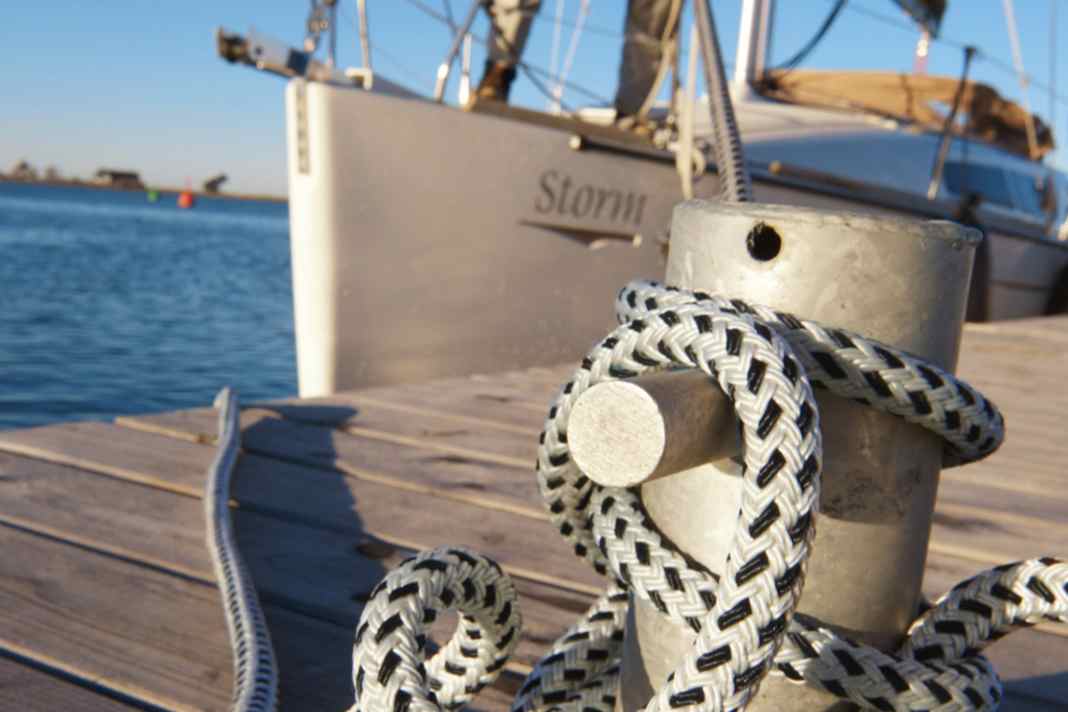



- Breaking load and elongation - that's what mooring lines are all about
- Splice disturbs the force distribution in the mooring line
- Choice of material hardly plays a role in abrasion resistance
- A lot of stretching is easy on the nerves and fittings
- Stretching in detail
- This is how we tested
- These are the test results
- Test winner
- Price-performance tip
If a mooring line is already cut to length ex works and fitted with a spliced-in eye, it is referred to as prefabricated cordage. Whether as a private label or no-name product, ready-made mooring lines are often offered at surprisingly favourable prices. Sometimes you pay just as much for a ready-to-use line from a low-cost supplier as for a line of the same length from a reel. Even with branded ropes, it's worth reaching for the finished product. A line made up by the manufacturer is even around one euro per metre cheaper than a mooring line spliced later by the supplier.
It is to be expected that the lines offered directly by the rope manufacturer are technically comparable to the pure reel product. But what about the rope quality of the finished products from the lowest price segment?
In order to clarify this question, we invited the major shippers and cordage suppliers to take part in a test. A total of 17 mooring lines found their way to the editorial office. In addition to the cordage manufacturers Gleistein, Liros, Teufelberger/Robline and Premiumropes, the splicing company Ropetec and the shipper SVB also supplied material.
Also interesting:
Interestingly, some of these are also branded products, such as those from Gleistein, while others are products from China. The latter does not have to be worse per se. China is particularly well positioned in the textile sector and can supply good quality polyester fibres at unbeatable prices. However, whether the line braided and spliced from these fibres makes a good mooring line is another matter.
Breaking load and elongation - that's what mooring lines are all about
First and foremost, a mooring line must have sufficient strength to keep the boat securely moored even in strong winds, that is clear. In addition, the line should offer as much stretch as possible, because the more energy is absorbed by the change in length, the softer the boat jerks in, which reduces the strain on the cleats and makes staying on board more comfortable. However, none of this helps if the rope gives way to fibres at the first biting attack of a rusty iron ring or the concrete quayside. Abrasion resistance is therefore also an important point.
All the more so as our test revealed some dramatic breaking load losses, even though the lines did not appear particularly damaged after the abrasion test. In fact, you will find mooring lines with similar chafe marks on many boats. The bottom photo in the table shows the chafe test in each case. However, the rope should not be too stiff either, as it should be easy to cover and shoot up. A tendency to kink is also undesirable. Slip lines that do not run out cleanly can quickly cause problems for crew and skipper when manoeuvring in the harbour.
Scrubbing causes enormous damage
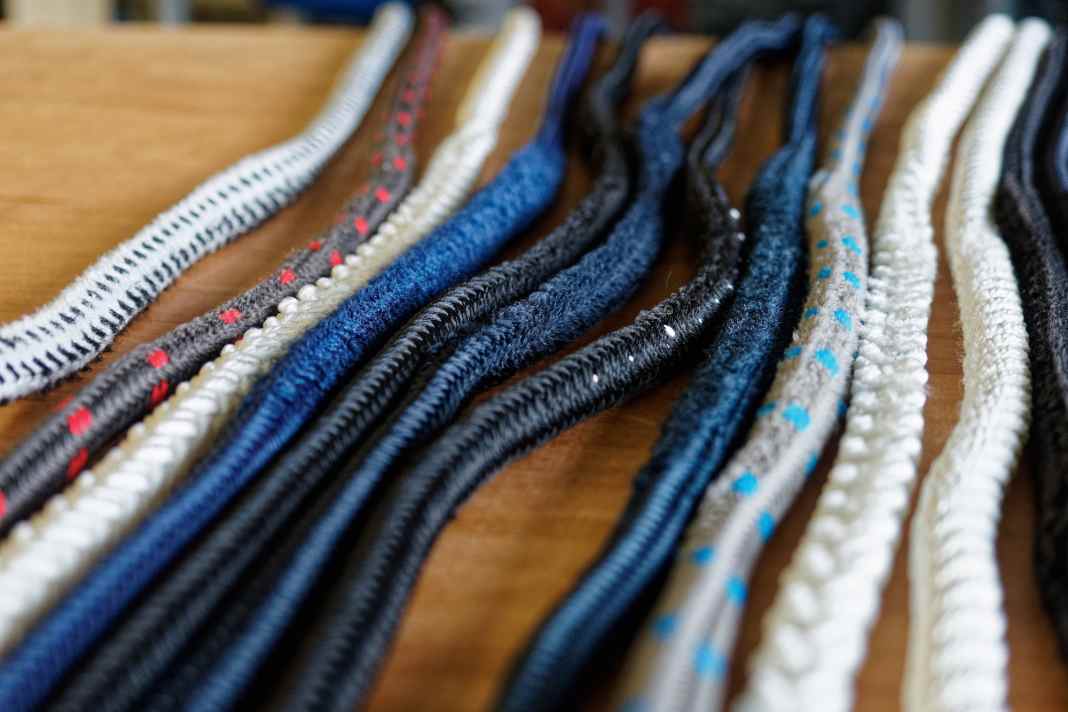


It is difficult to fulfil all requirements perfectly, which is why manufacturers offer a range of variants. This starts with the choice of base material. Polyester and polyamide, also known under the brand name nylon, are the most suitable. Polypropylene, which is also available, is very cheap, but is also much more sensitive to light and abrasion. It therefore ages very quickly and becomes bone hard. It should only be used as a mooring line if the line absolutely has to be buoyant, which is why we have not included polypropylene ropes.
We based the diameters on a virtual, ten metre long test boat. A minimum breaking load of 3,000 decanewtons was required, resulting in 14 millimetre thick lines. The mooring line Navy supplied by SVB did not meet this specification according to the catalogue. In the test, however, the line reached over 4,000 decanewtons. The situation is similar with the Porto from Liros; it is labelled at just under 3,000 decanewtons, but in practice it was over 4,100 decanewtons. This is despite the fact that we did not test the so-called linear breaking load of the rope in our test.
Splice disturbs the force distribution in the mooring line
As we wanted to know whether the splices could be trusted, we placed the eye of the mooring line over a bolt and only tensioned the other end of the line on pulleys. As a result, the mooring lines usually broke about ten centimetres behind the end of the splice. Exactly where it was to be expected. The splice disturbs the distribution of force in the rope, which is why the greatest stresses occur at the transition from the free line to the splice. It is generally assumed that a good splice reduces the breaking load of the rope by around ten per cent. A comparison with the linear breaking loads determined in a previous test confirms this assumption for the lines tested at that time. For comparison: We also tested the Handy Elastic and the Squareline from Liros with a knotted eye. The bowline reduces the strength by 43 per cent compared to the splice.
However, it was astonishing that even the very short and barely tapered splices of the Cruising mooring line, the Navy mooring line and the dockline from Premium Ropes have sufficient strength. A neatly tapered splice, such as those on Liros or Gleistein products, looks much more harmonious. In addition, the splices from the brand manufacturers worked somewhat less. For the elongation measurement, the lines were preloaded with half the breaking load in accordance with the EN ISO 2307 standard. The splice of the Cruising mooring line was around four centimetres longer, while the value for the ropes from Gleistein and Liros was only half as high, which indicates more careful workmanship.
It is therefore not surprising that Gleistein's Dockflex has the highest breaking load in the test at 4,513 decanewtons. In practice, however, the breaking load of a mooring line only plays an indirect role, as it is used to derive the working load. According to the recommendations of the classification society DNV GL, it should not exceed 20 per cent of the breaking load, which corresponds to values between 606 and 903 decanewtons for the test candidates.
However, higher breaking loads and therefore working loads offer scope for mechanical damage to the rope. To test the abrasion resistance, we chafed all lines under exactly the same conditions as in the last test and then determined the breaking load of the damaged rope.
Choice of material hardly plays a role in abrasion resistance
Ropetec's high-performance fastener shows the least damage, with just under 70 per cent of the original strength still present. However, this result should be viewed with caution, as the high-performance mooring line is the same as the Dock-Flex, but has an integrated shock absorber. This consists of a bundle of rubber strops about 55 centimetres long, which are inserted into the core of the line 45 centimetres behind the eye. This results in very good stretch behaviour, but also creates a fault in the rope structure and reduces the breaking load of the undamaged line by 28 percent compared to the Dock-Flex.
In absolute terms, the high-performance fastener is therefore only in the upper midfield in terms of chafing and clearly behind the primus Docktwin from Gleistein, which was sent into the race under the name Flexy from Ropetec.
The worst performers were Vinga from Teufelberger and Dockline from Premium Ropes. They lost 46 and 52 per cent of their strength respectively, putting them behind even the Squareline from Liros in absolute terms, which suffered the greatest percentage loss but still holds 1,683 decanewtons thanks to its high breaking load.
The choice of material, i.e. polyester or polyamide, plays practically no role in the abrasion resistance, both plastics are roughly on a par. And there is also no clear picture when it comes to construction. Depending on the manufacturer, core-shell braids and squarelines sometimes perform better, sometimes worse.
The insidious thing about abrasion resistance is the discrepancy between the visual impression of the line and its actual residual strength. The Handy Elastic, which at first glance appears almost intact, lost 50 per cent of its breaking load, similar to the visually much more impaired Docktwin. The fibres must therefore also have been damaged inside the line (see page 83).
A lot of stretching is easy on the nerves and fittings
Ropes made of polyamide have a clear advantage in the elongation measurement, offering up to three times more stretch than polyester ropes. These differences were already apparent during the testing. While the polyester ropes could be pulled to the breaking point in a single operation without any problems after the obligatory pre-tensioning, the polyamide products did not have enough travel for the tensile testing machine - it was so prolonged that we had to interrupt the tensile tests and re-tension the batches.
Polyamide is clearly superior
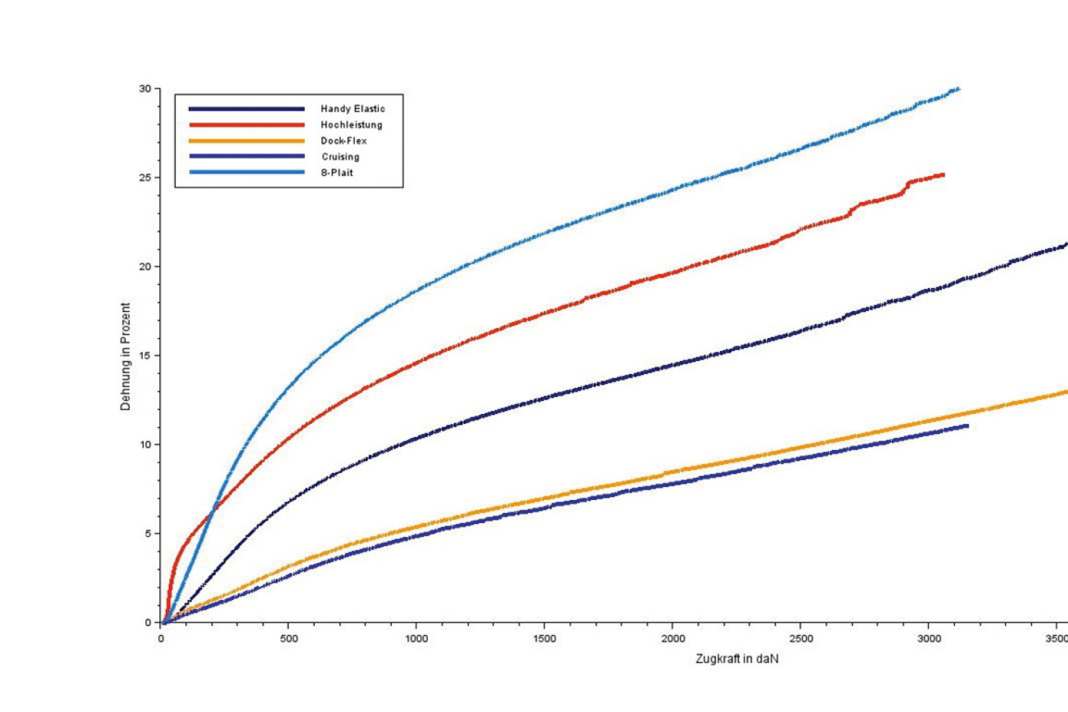



The nylon squareline from Robline has the highest elongation. It stretches by around 17 per cent under working load and also achieves the best values with our comparative load of 600 decanewtons. At the other end of the scale are the Cruising mooring line and the Navy mooring line from SVB as well as the Marstand from Carl Marks/Liros with values between 2.8 and 3.3 per cent. If you have lines like these on board, you have to reckon with hard jamming in swell. In any case, it is advisable to retrofit shock absorbers.
Of course, both would be ideal, a stretchable rope and an additional rubber buffer in rough harbours. This is precisely the approach taken by Ropetec with the aforementioned high-performance mooring line with integrated rubber stop. At just under 12 per cent, the elongation values are in the range of good polyamide lines.
The elongation values make nylon ropes predestined for mooring, but this is countered by another material property: polyamide absorbs water, with the result that the fibres shrink. In practice, this means that The lines can become stiff and unwieldy after a short time. Lay ropes harden particularly quickly; core-sheath braids and squarelines, on the other hand, are less critical. Modern polyamide ropes therefore retain their suppleness for several years. When they become stiff, it is usually time to replace them anyway. Polyester lines are then sometimes still supple, but stretch just as little as on the first day.
Stretching in detail
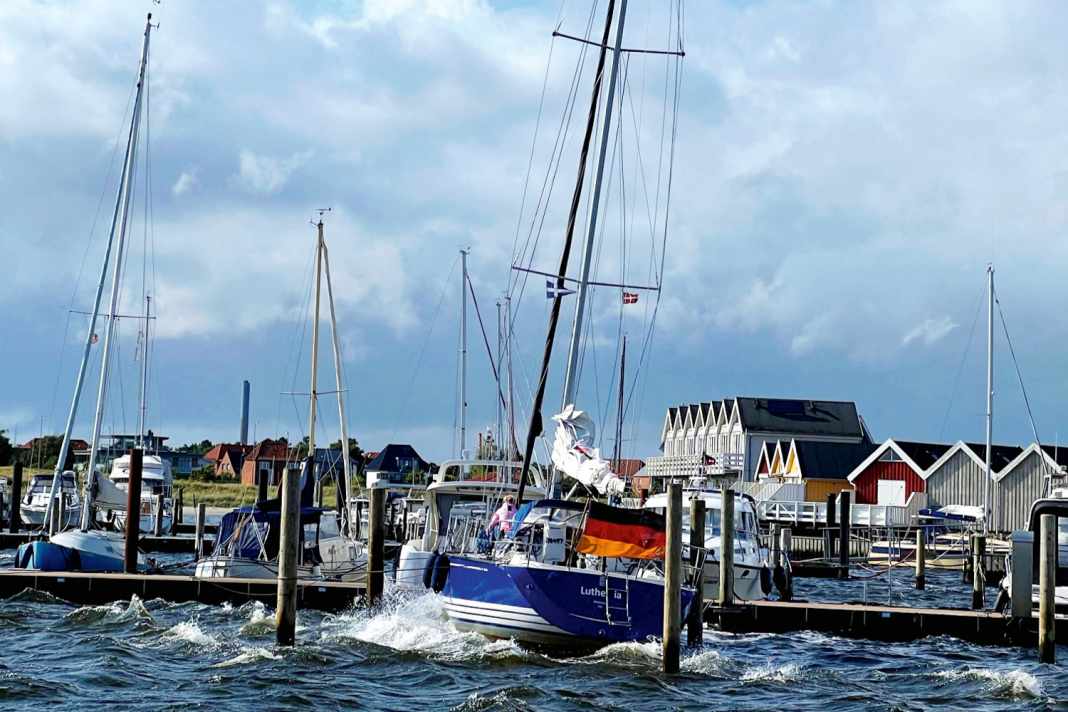


In conditions such as those shown in the picture, the mooring lines should be able to absorb as much energy as possible. This requires high elongation values. For comparison purposes, we have not used the maximum stretch of the rope at break, but a load standardised to 600 decanewtons. This means that the different breaking and working loads of the lines do not play a role. The diagram shows the differences in elongation between the individual working load and the standardised value.
Core-sheath constructions are by far the most popular and also dominate the test field. This is mainly due to their handling, they nestle well around cleats and run out evenly as a slip line. The Handy Elastic in particular lives up to its name. It is the most comfortable and supple line in the test. It is closely followed by the Flexy/Docktwin and the Marstrand. It is difficult to discern any differences in the other core-sheath constructions. They are therefore very close together in the evaluation.
The two square lines from Liros and Robline are very supple and also perform well in terms of handling. However, due to their design, they tend to pull individual fibres out of the rope on rough surfaces.
If you remember that the fate of a pleasure craft depends on the lines for around 160 days in a typical Northern European season, it becomes clear that no compromises should be made when deciding on ropes.
The good news: even with the cheapest products, the pre-assembled splices hold. In terms of workmanship, there is nothing to be said against a ready-made line. Even the simple splices offer significantly greater strength than an eye knotted in with a bowline knot. In terms of abrasion resistance, however, the branded products tend to perform better. Three of the four weakest lines come from the lower price segment.
However, the biggest differences are material-related. With their high stretch, polyamide lines are the first choice for mooring lines. They not only ensure relaxed nights on board, but also protect the fittings. As a rule, they offer higher breaking loads, which provides greater safety reserves in the event of damage. Considering the enormous loss of strength associated with damage to the lines, the mooring lines should be replaced anyway whenever damage is recognised.
With very good elongation, the 8-plait Squareline from Robline the test victory, followed by Flexy/Docktwin from Ropetec/Gleistein and Handy Elastic from Liros as the best core-shell braids. Also among the top 4 is the Palma Elastic from Robline; as the cheapest polyamide line, it gets the price-performance tip. The best polyester product is the Dock-Flex from SVB/Gleistein. The high performance fastener made from the same material has to make concessions in terms of price and breaking load, but has very good elongation values.
This is how we tested
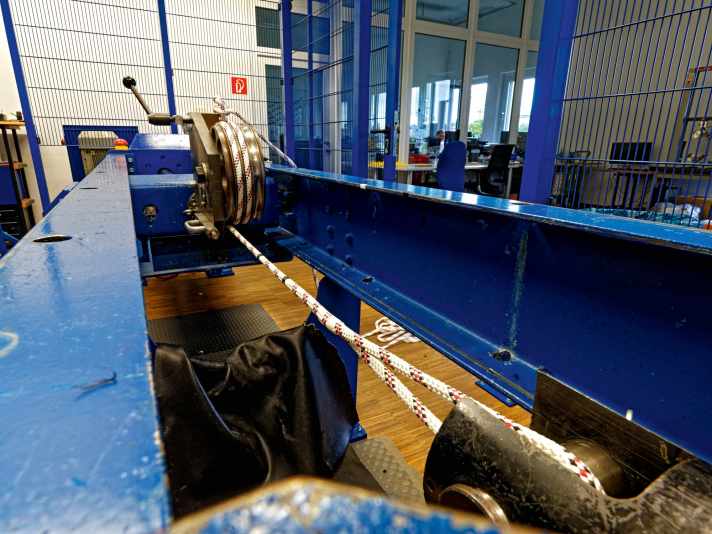
We spent a good three days in the Liros testing laboratory to test the mooring lines. As you can see in the picture, elongation and breaking load were determined on the tear test machine by placing the spliced eye over a thick bolt. Three samples of each model were tested
and the mean values were calculated. In the abrasion test, we selected the number of abrasion cycles in preliminary tests so that no line was completely destroyed. After this ordeal, the breaking load of the damaged rope was determined.
These are the test results
Test winner
8-plait nylon from Robline



Price (RRP) / per metre (10): 44,00 € / 5,50 € (6)
- Material: Polyamide
- Construction: Squareline
- Length/alternatives: 8 m / -
- Diameter [mm]: 14 mm
- Eye size [mm]: 360 mm
- Breaking load [daN]: 4,090 daN
- Diameter: 13.7 mm
- Weight [g/m]: 109.61 g/m
- Average breaking load (20): 4,169 daN (15)
- Workload, 20 % of the BL: 834 daN
- Deviation BL: 102 %
- Average elongation at break: 38 %
- Breaking load after chafing (20): 2,096 daN (11)
- Weakening, percentage-wise: 50 %
- Medium elongation with AL: 17,3 %
- Average elongation at 600 daN (30): 14,7 % (30)
- Handling (20): very good (17)
- Comment: Very soft and supple square line, tends to pull threads. Highest stretch in the test. Splice well processed. End melted off, no rigs
Rating (100): (79)
Cruising festive maker from SVB



- Price (RRP) / per metre (10): 31,95 € / 3,99 € (8)
- Material: Polyester
- Construction: Core-shell
- Length/alternatives: 8 m / 6; 12; 14; 15 m
- Diameter [mm]: 14 mm
- Eye size [mm]: 600 mm
- Breaking load [daN]: 3,700 daN
- Diameter: 13.7 mm
- Weight [g/m]: 138.47 g/m
- Average breaking load (20): 3,594 daN (8)
- Workload, 20 % of the BL: 719 daN
- Deviation BL: 97 %
- Average elongation at break: 12 %
- Breaking load after chafing (20): 2187 daN (13)
- Weakening, percentage-wise: 39 %
- Medium elongation with AL: 3,8 %
- Average elongation at 600 daN (30): 3,2% (1)
- Handling (20): good (16)
- Comment: The cordage is loose and somewhat uncleanly braided, individual strands of yarn form loops. The splice settles heavily even when pre-loaded and is barely tapered. Very low elongation
- Rating (100): (46)
Dock-Flex from Gleistein



- Price (RRP) / per metre (10): 54,95 € / 6,87 € (4)
- Material: Polyester
- Construction: Core-shell
- Length/alternatives: 8 m / 12; 14; 15 m
- Diameter [mm]: 14 mm
- Eye size [mm]: 600 mm
- Breaking load [daN]: 4,100 daN
- Diameter: 12.6 mm
- Weight [g/m]: 122.28 g/m
- Average breaking load (20): 4,513 daN (20)
- Workload, 20 % of the BL: 903 daN
- Deviation BL: 110 %
- Average elongation at break: 16 %
- Breaking load after chafing (20): 2,340 daN (16)
- Weakening, percentage-wise: 48 %
- Medium elongation with AL: 5,0 %
- Average elongation at 600 daN (30): 3,7 % (2)
- Handling (20): very good (17)
- Comment: Slightly tighter braiding, but still supple. Corresponds to the high-performance stabiliser only without integrated shock absorber, therefore low elongation typical of polyester. Highest breaking load
- Rating (100): (59)
Dockline from Premium Ropes



- Price (RRP) / per metre (10): 45,00 € / 3,00 € (9)
- Material: Polyester
- Construction: Core-shell
- Length/alternatives: 15 m / 6; 8; 12 m
- Diameter [mm]: 14 mm
- Eye size [mm]: 400
- Breaking load [daN]: 3,250 daN
- Diameter: 12.7 mm
- Weight [g/m]: 111.74 g/m
- Average breaking load (20): 3,341 daN (5)
- Workload, 20 % of the BL: 668 daN
- Deviation BL: 103 %
- Average elongation at break: 15 %
- Breaking load after chafing (20): 1,620 daN (0)
- Weakening, percentage-wise: 52 %
- Medium elongation with AL: 4,2 %
- Average elongation at 600 daN (30): 3,8 % (3)
- Handling (20): very good (17)
- Comment: Very supple line. Rigging at the splice breaks when pre-loaded, but this is only a visual defect as the rigging is not necessary. Line end taped and melted off
- Rating (100): (34)
Mooring dock from Ropetec



- Price (RRP) / per metre (10): 21,00 € / 2,63 € (10)
- Material: Polyester
- Construction: Core-shell
- Length/alternatives: 8 m / 5; 10; 12; 15 m
- Diameter [mm]: 14 mm
- Eye size [mm]: 400 mm
- Breaking load [daN]: 3,700 daN
- Diameter: 13.8 mm
- Weight [g/m]: 134.98 g/m
- Average breaking load (20): 3,767 daN (10)
- Workload, 20 % of the BL: 753 daN
- Deviation BL: 102 %
- Average elongation at break: 16 %
- Breaking load after chafing (20): 2,034 daN (9)
- Weakening, percentage-wise: 46 %
- Medium elongation with AL: 4,7 %
- Average elongation at 600 daN (30): 4,0 % (3)
- Handling (20): good (16)
- Comment: Splice tapered, but ends with a noticeable step. Cleanly finished. No superfluous rigging at the splice. End is tapered and melted. Good stretch for polyester
- Rating (100): 48
Mooring line Navy from SVB / Seago



- Price (RRP) / per metre (10): 32,95 € / 3,30 € (9)
- Material: Polyester
- Construction: Core-shell
- Length/alternatives: 10 m / 8; 15 m
- Diameter [mm]: 14 mm
- Eye size [mm]: 300 mm
- Breaking load [daN]: 2,800 daN
- Diameter: 13.4 mm
- Weight [g/m]: 126.88 g/m
- Average breaking load (20): 4,081 daN (14)
- Workload, 20 % of the BL: 816 daN
- Deviation BL: 146 %
- Average elongation at break: 15 %
- Breaking load after chafing (20): 2,361 daN (16)
- Weakening, percentage-wise: 42 %
- Medium elongation with AL: 3,8 %
- Average elongation at 600 daN (30): 2,8 % (0)
- Handling (20): good (16)
- Comment: Very short splice that is barely tapered. Splice clearly settles when preloaded. Rigging comes loose. End betacked, glued and melted off. Very low elongation
- Rating (100): (55)
Premium Ropes from Flexi Dock



- Price (RRP) / per metre (10): 62,50 € / 7,81€ (3)
- Material: Polyamide
- Construction: Core-shell
- Length/alternatives: 8 m /14 m
- Diameter [mm]: 14 mm
- Eye size [mm]: 400 mm
- Breaking load [daN]: 3,700 daN
- Diameter: 12.0 mm
- Weight [g/m]: 111.16 g/m
- Average breaking load (20): 3,640 daN (8)
- Workload, 20 % of the BL: 728 daN
- Deviation BL: 98 %
- Average elongation at break: 30 %
- Breaking load after chafing (20): 2,157 daN (12)
- Weakening, percentage-wise: 41 %
- Medium elongation with AL: 9,9 %
- Average elongation at 600 daN (30): 8,9 % (15)
- Handling (20): good (14)
- Comment: Supple, non-slip line. The core easily pushes out of the sheath on heavily loaded kinks. End melted off. Good elongation
- Rating (100): (52)
Flexy/Docktwin from Ropetec/Gleistein



- Price (RRP) / per metre (10): 52,90 € / 6,61 € (5)
- Material: Polyester, polyamide
- Construction: Core-shell
- Length/alternatives: 8 m / 5; 10; 12; 15 m
- Diameter [mm]: 14 mm
- Eye size [mm]: 600 mm
- Breaking load [daN]: 5,100 daN
- Diameter: 13.1 mm
- Weight [g/m]: 115.15 g/m
- Average breaking load (20): 4,447 daN (19)
- Workload, 20 % of the BL: 889 daN
- Deviation BL: 87 %
- Average elongation at break: 23 %
- Breaking load after chafing (20): 2,522 daN (20)
- Weakening, percentage-wise: 43 %
- Medium elongation with AL: 8,6 %
- Average elongation at 600 daN (30): 6,7 % (10)
- Handling (20): very good (18)
- Comment: Supple, very grippy line with cleanly processed and well tapered splice. Taked and melted end. High breaking load
- Rating (100): (72)
Handy Elastic from Liros



- Price (RRP) / per metre (10): 65,95 € / 8,24 € (3)
- Material: Polyamide
- Construction: Core-shell
- Length/alternatives: 8 m / 6; 12; 14; 15 m
- Diameter [mm]: 14 mm
- Eye size [mm]: 600 mm
- Breaking load [daN]: 3,840 daN
- Diameter: 12.6 mm
- Weight [g/m]: 103.27 g/m
- Average breaking load (20): 4,363 daN (18)
- Workload, 20 % of the BL: 873 daN
- Deviation BL: 114 %
- Average elongation at break: 26 %
- Breaking load after chafing (20): 2,165 daN (12)
- Weakening, percentage-wise: 50 %
- Medium elongation with AL: 9,6 %
- Average elongation at 600 daN (30): 7,7 % (12)
- Handling (20): very good (20)
- Comment: Smoothest line in the test. Cleanly processed and nicely tapered splice. Tapered and melted end. Good elongation and high breaking load
- Rating (100): (65)
High-performance fasteners from Ropetec



- Price (RRP) / per metre (10): 81,95 € / 10,24 € (0)
- Material: Polyester
- Construction: Core-shell
- Length/alternatives: 8 m / 10; 14; 15; 18 m
- Diameter [mm]: 14 mm
- Eye size [mm]: 600 mm
- Breaking load [daN]: 4,100 daN
- Diameter: 13.1 mm
- Weight [g/m]: 122.40 g/m
- Average breaking load (20): 3,279 daN (4)
- Workload, 20 % of the BL: 656 daN
- Deviation BL: 80 %
- Average elongation at break: 26 %
- Breaking load after chafing (20): 2,320 daN (16)
- Weakening, percentage-wise: 29 %
- Medium elongation with AL: 11,9 %
- Average elongation at 600 daN (30): 11,4 % (22)
- Handling (20): good (16)
- Comment: See Dock-Flex, but with integrated shock absorber, therefore very high elongation over a large load range. Clean finish, end with Flemish eye
- Rating (100): (58)
Marstrand by Carl Marks / Liros



- Price (RRP) / per metre (10): 21,00 € / 3,50 € (9)
- Material: Polyester
- Construction: Core-shell
- Length/alternatives: 6 m / 10; 15 m
- Diameter [mm]: 14 mm
- Eye size [mm]: 400 mm
- Breaking load [daN]: 3,700 daN
- Diameter: 12.8 mm
- Weight [g/m]: 116.59 g/m
- Average breaking load (20): 3,727 daN (10)
- Workload, 20 % of the BL: 745 daN
- Deviation BL: 101 %
- Average elongation at break: 14 %
- Breaking load after chafing (20): 1,635 daN (0)
- Weakening, percentage-wise: 56 %
- Medium elongation with AL: 4,0 %
- Average elongation at 600 daN (30): 3,3 % (1)
- Handling (20): very good (18)
- Comment: Very supple line. Coat a little wide. Comparatively short splice. End betacked and melted, slight stretch
- Rating (100): (38)
Price-performance tip
Palma Elastic from Robline



- Price (RRP) / per metre (10): 49,00 € / 4,90 (7)
- Material: Polyamide
- Construction: Core-shell
- Length/alternatives: 10 m/8 m
- Diameter [mm]: 14 mm
- Eye size [mm]: 360 mm
- Breaking load [daN]: 4,620 daN
- Diameter: 13.8 mm
- Weight [g/m]: 111.92 g/m
- Average breaking load (20): 3,693 daN (9)
- Workload, 20 % of the BL:739 daN
- Deviation BL: 80 %
- Average elongation at break: 25 %
- Breaking load after chafing (20): 2,467 daN (19)
- Weakening, percentage-wise: 33 %
- Medium elongation with AL: 8,9 %
- Average elongation at 600 daN (30): 7,9 % (13)
- Handling (20): good (16)
- Comment: Smooth line with good stretch. Splice nicely tapered. Rigging breaks when pre-loaded. End melted off
- Rating (100): (64)
Postage from Liros



- Price (RRP) / per metre (10): 45,52 € / 7,59 (3)
- Material: Polyester
- Construction: Core-shell
- Length/alternatives: 6 m / 10; 15 m
- Diameter [mm]: 14 mm
- Eye size [mm]: 400 mm
- Breaking load [daN]: 2,960 daN
- Diameter: 13.4 mm
- Weight [g/m]: 132.28 g/m
- Average breaking load (20): 4,110 daN (15)
- Workload, 20 % of the BL: 822 daN
- Deviation BL: 139 %
- Average elongation at break: 15 %
- Breaking load after chafing (20): 2,276 daN (15)
- Weakening, percentage-wise: 45 %
- Medium elongation with AL: 4,4 %
- Average elongation at 600 daN (30): 3,5 % (2)
- Handling (20): good (16)
- Comment: Supple, well-made line. High breaking load, but low elongation typical of polyester. End is betacked and melted
- Rating (100):
Rapallo from Robline



- Price (RRP) / per metre (10): 23,90 € / 2,39 € (10)
- Material: Polyester
- Construction: Beaten
- Length/alternatives: 10 m / 4; 6 m
- Diameter [mm]: 14 mm
- Eye size [mm]: 360 mm
- Breaking load [daN]: 3,900 daN
- Diameter: 14.4 mm
- Weight [g/m]: 136.94 g/m
- Average breaking load (20): 3,571 daN (8)
- Workload, 20 % of the BL: 714 daN
- Deviation BL: 92 %
- Average elongation at break: 18 %
- Breaking load after chafing (20): 1,962 daN (8)
- Weakening, percentage-wise: 45 %
- Medium elongation with AL: 6,2 %
- Average elongation at 600 daN (30): 5,4 % (7)
- Handling (20): good (14)
- Comment: Only beaten line in the test. Good stretch behaviour for polyester. End melted off
- Rating (100): (47)
Rio from Robline



- Price (RRP) / per metre (10): 44,95 € / 4,50 € (7)
- Material: Polyester
- Construction: Core-shell
- Length/alternatives: 10 m / 5; 7 m
- Diameter [mm]: 14 mm
- Eye size [mm]: 350 mm
- Breaking load [daN]: 3,700 daN
- Diameter: 13.1 mm
- Weight [g/m]: 121.30 g/m
- Average breaking load (20): 3,413 daN (5)
- Workload, 20 % of the BL: 683 daN
- Deviation BL: 92 %
- Average elongation at break: 12 %
- Breaking load after chafing (20): 1,833 daN (5)
- Weakening, percentage-wise: 46 %
- Medium elongation with AL: 4,0 %
- Average elongation at 600 daN (30): 3,7 % (2)
- Handling (20): good (16)
- Comment: Visually similar to the mooring line with eye from Ropetec. Supple line with low stretch and moderate breaking load. End is betacked and melted
- Rating (100): (35)
Squareline PA from Liros



- Price (RRP) / per metre (10): 54,00 € / 6,75 € (4)
- Material: Polyamide
- Construction: Squareline
- Length/alternatives: 6 m / 10; 15 m
- Diameter [mm]: 14 mm
- Eye size [mm]: 300 mm
- Breaking load [daN]: 3,600 daN
- Diameter: 15.1 mm
- Weight [g/m]: 116.85 g/m
- Average breaking load (20): 3,952 daN (13)
- Workload, 20 % of the BL: 790 daN
- Deviation BL: 110 %
- Average elongation at break: 31 %
- Breaking load after chafing (20): 1,683 daN (1)
- Weakening, percentage-wise: 57 %
- Medium elongation with AL: 14,8 %
- Average elongation at 600 daN (30): 12,8 % (25)
- Handling (20): very good (18)
- Comment: Compact braided square line. Slightly stiffer than the 8-plait from Robline. However, it is not quite as easy to pull threads out of the braid. Good stretch behaviour. End is barbed and melted
- Rating (100): (61)
Vinga from Robline



- Price (RRP) / per metre (10): 25,00 € / 4,17 € (8)
- Material: Polyester
- Construction: Core-shell
- Length/alternatives: 6 m / 12 m
- Diameter [mm]: 14 mm
- Eye size [mm]: 360 mm
- Breaking load [daN]: Not specified
- Diameter: 12.7 mm
- Weight [g/m]: 111.89 g/m
- Average breaking load (20): 3028 daN (0)
- Workload, 20 % of the BL: 606 daN
- Deviation BL: not specified
- Average elongation at break: 13 %
- Breaking load after chafing (20): 1,626 daN (0)
- Weakening, percentage-wise: 46 %
- Medium elongation with AL: 4,0 %
- Average elongation at 600 daN (30): 4,0 % (3)
- Handling (20): good (16)
- Comment: Supple line with low breaking load. But also has a comparatively low weight for a polyester line, which speaks in favour of fewer fibres. End taped, glued and melted off
- Rating (100): (27)

